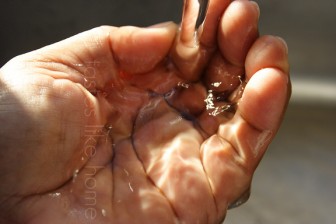Hi Everyone,
Ever wonder why you love the Coca Cola in one country but can’t stand the taste of it elsewhere? Ever wonder why you prefer certain beers? Ever wonder why the pizza in one place tastes different from another place? Ever wonder why the same international brands of items taste different from one country to another? Read on.
To say that water plays a big role in food and beverage would be a gross understatement. From germination to consumption, water influences and determines the flavour, taste and texture of what we eat and drink. In order to understand its influence, let us first determine what is coming through our taps.
For the purpose of this column, I am looking at the two major types of water – “hard water” and “soft water”. Depending on your location, you may be getting well water or artesian well water, but let’s shelve that for now. “Hard water” is water that has a high amount of dissolved minerals, specifically calcium and magnesium. Let me hasten to add that the World Health Organization and other independent and influential bodies have conducted tests to show that hard water is not a health risk. How does water become “hard”? As the water moves through soil and rock, it dissolves very small amounts of minerals and holds them in solution. Calcium and magnesium are the two most common minerals that make the water “hard”.
 Here’s how you can easily find out if you get hard water (well apart from calling the water authority). There is a lot of lime scale and calcium build up on your showerheads, in your kettle etc. It is a nightmare when it comes to plumbing as you can find many things clogged as a result of the calcium build up often described as lime scale. When you wash glassware and see all the spots as if the glass is still dirty, that is the effect of the mineral residue from hard water. Boil some water in a pot and notice how the rim of the inside of the pot gets a kind of white mask. Here in Barbados, we get hard water. In most of the United States they get hard water too. With hard water, soaps and detergents do not lather a lot and so you find that you end up using more. It is one of the many reasons why fabric softener is used – not exclusively to make the clothes smell nice but to relax the fibres, make the fabric less stiff (due to the high mineral content of the water) and lengthen the life of the clothing.
Here’s how you can easily find out if you get hard water (well apart from calling the water authority). There is a lot of lime scale and calcium build up on your showerheads, in your kettle etc. It is a nightmare when it comes to plumbing as you can find many things clogged as a result of the calcium build up often described as lime scale. When you wash glassware and see all the spots as if the glass is still dirty, that is the effect of the mineral residue from hard water. Boil some water in a pot and notice how the rim of the inside of the pot gets a kind of white mask. Here in Barbados, we get hard water. In most of the United States they get hard water too. With hard water, soaps and detergents do not lather a lot and so you find that you end up using more. It is one of the many reasons why fabric softener is used – not exclusively to make the clothes smell nice but to relax the fibres, make the fabric less stiff (due to the high mineral content of the water) and lengthen the life of the clothing.
In Guyana, the water is soft.

Soft water is simply water that does not contain calcium or magnesium, but in soft water, you will find sodium. And it works the opposite to hard water in that soaps and detergents lather generously; there is barely any lime scale build up on faucets and there’s hardly the kind of plumbing problems related to hard water build up.
Can you begin to see now how this same water – hard or soft can alter and affect the taste, flavour and texture of your food? Due to the pivotal usage of water for the preparation and consumption of our food and beverage, there is no getting away from the water impacting our food. It is one of the reasons that people swear by some products, whether it is made in a particular location, country or eating establishment.
Take one of my personal favourite examples, Coca Cola. I enjoy Coca Cola in Guyana and have it whenever I am there. Apart from that I don’t drink Coca Cola else where because the taste is not the same, though the formula is standard given that it is a franchise. Of course the sugar, the sweetener, also has an impact. The quality of that sugar would have been impacted through growth by the water. See how it is all connected and interlinked? It is easy to see then how one country can win the medal for best the Coca Cola when the world over, Coca Cola is being made with the same formula. Or we can understand why the Banks beer in Guyana is different from the Banks beer in Barbados.
Water is the main ingredient in beer and the quality of the water has a definite influence on the quality of a beer. These days, with modern technology, brewers can adjust the mineral content in the water to suit the kind of beer they are going to make, but long ago brewers tailored their brews based on the kind of local water available. Other beverages such as tea, coffee and wine are heavily influenced by the quality of the water.
Treats made with dough are distinctive in terms of taste, texture and flavour based on the water used, especially breads. In the United States there are arguments about which pizza is the best, East Coast or West Coast, while the taste is an individual one, it really comes down to how the crust of the pizza tastes – its flavour, its texture. All of this as a result of how the chemical make-up of the water interacted with the yeast and gluten in the flour.
Bread made with hard water produces a firmer dough as a result of the “cross-linking effects of calcium and magnesium” explains renowned kitchen science expert, Harold McGee.
The water we get determines the taste of our vegetables, our fruits and yes, even the meat that we eat. According to McGee, raw meat is 75% water by weight and fruits and vegetables 95%! It is no wonder that our palettes are so attuned in differentiating the taste of a pineapple from Hawaii as opposed to a pineapple from elsewhere. In many cases we do not even have to go outside a country to prefer the distinctive taste of something. Guyana is made up of three counties and people will often tell you that you haven’t eaten (fill in the blank), until you’ve had it from Essequibo, Berbice or Linden.
I can hear the wheels in your head turning now as you make the connections and think of the things you’ve eaten or drunk and always wondered why they taste so different, so right, so perfect. Share them with me.





